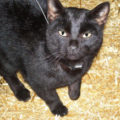
Veterinary specialists in the UK have authored an intriguing paper regarding certain types of feline seizures, which appear to occur in response to certain high-pitched sounds.
The paper, entitled “Audiogenic reflex seizures in cats,” has been published in theJournal of Feline Medicine and Surgery and is based on data from 96 cats.
It reveals that some cats do indeed suffer from audiogenic reflex seizures – those which are consistently caused by sounds, myoclonic seizures (brief, shock-like jerks of a muscle or a group of muscles), or generalized tonic-clonic seizures. This last category is what most people think of as a “seizure,” with the cat losing consciousness and its body stiffening and jerking, often for several minutes.
The new syndrome has been termed feline audiogenic reflex seizures (FARS). It has also been dubbed “Tom and Jerry syndrome,” after the cartoon character Tom who has a strong startle reflex and often reacts with involuntary jerks to sound stimuli.
Looking at the type and duration of seizure and the triggering sound, paper authors Mark Lowrie and Laurent Garosi (both from Davies Veterinary Specialists), and Robert Harvey (from the UCL School of Pharmacy, London), found that FARS occurred both in pedigree and non-pedigree cats, but that among the pedigrees, the Birman breed (pictured) was over-represented. FARS was also found to be a problem in older cats – the average age of seizure onset was 15 years, with affected cats ranging in age from 10 to 19 years.
The most commonly reported triggers for FARS were the sound of crinkling tin foil (82 cats), a metal spoon clanging in a ceramic feeding bowl (79 cats), chinking or tapping of glass (72 cats), crinkling of paper or plastic bags (71 cats), tapping on a computer keyboard or clicking of a mouse (61), clinking of coins or keys (59), hammering of a nail (38) and even the clicking of an owner’s tongue (24).
Other, less common triggers were the sound of breaking the tin foil from packaging, mobile phone texting and ringing, digital alarms, Velcro, stove igniting ticks, running water, a dog jangling its collar as it scratched, computer printer, firewood splitting, wooden blocks being knocked together, walking across a wooden floor with bare feet or squeaky shoes and, in one case, the short, sharp scream of a young child.
The team is now working on a paper about treatment of FARS cases. “Levetiracetam is an excellent choice of medication in managing this condition. Our experience is that it can completely rid a cat of these sound-induced seizures, including the myoclonic twitches – one owner reported that levetiracetam had ‘truly been a miracle drug for my cat,”’ said lead author Mark Lowrie.
Related:
Discuss this article in our forum
Read the full study
Clever cats use mimicry when hunting
Cat Parasite Aiming For Global Male Domination
Boffin Ponders Cultural Manipulation By Cat Parasite









Comments are closed.